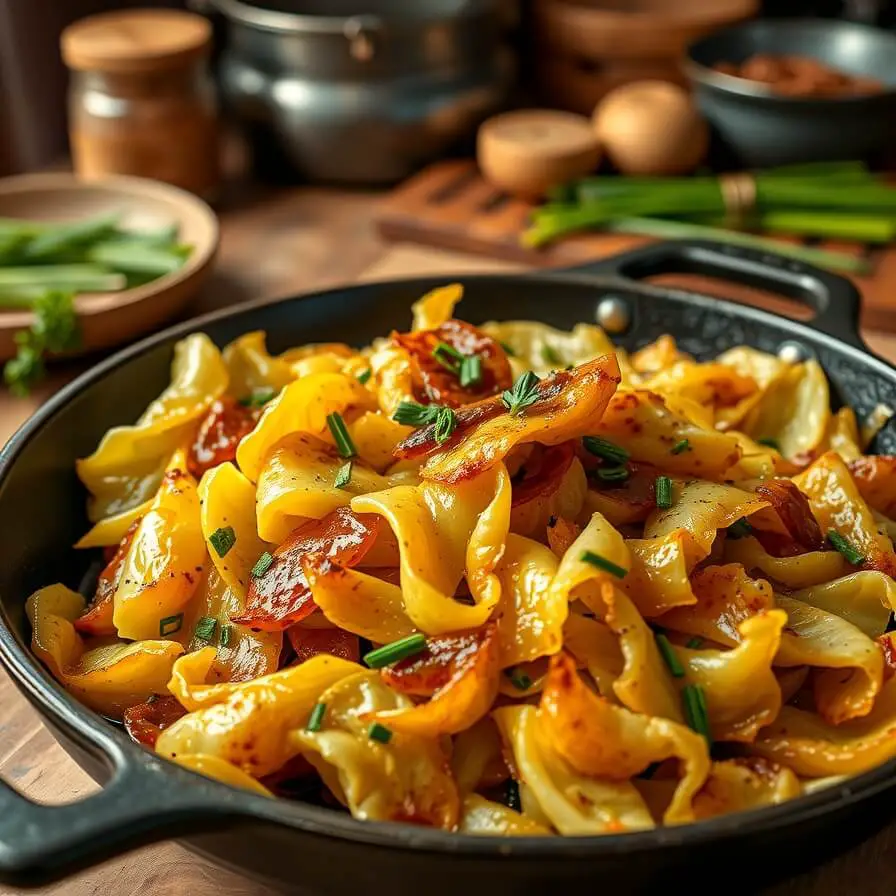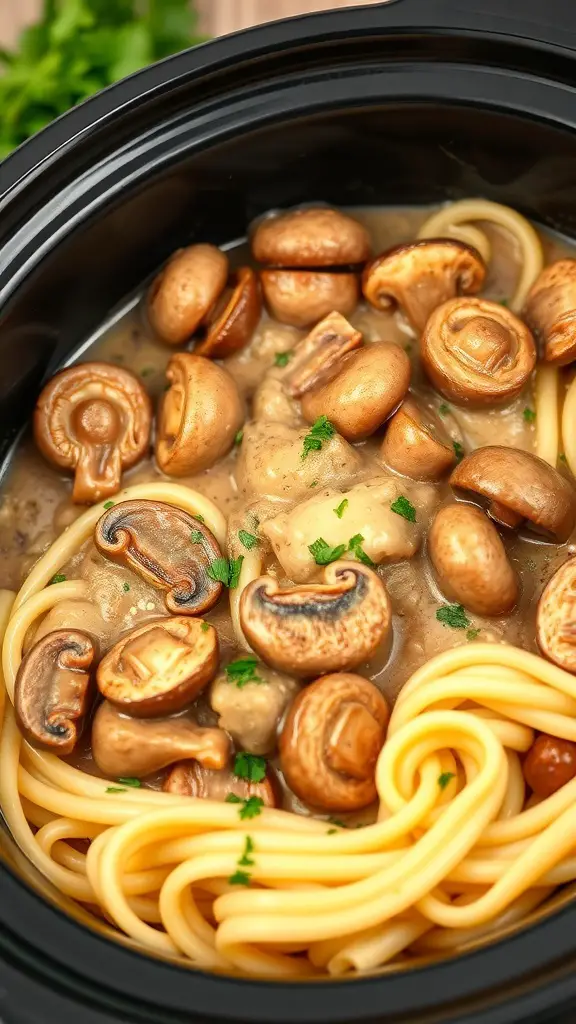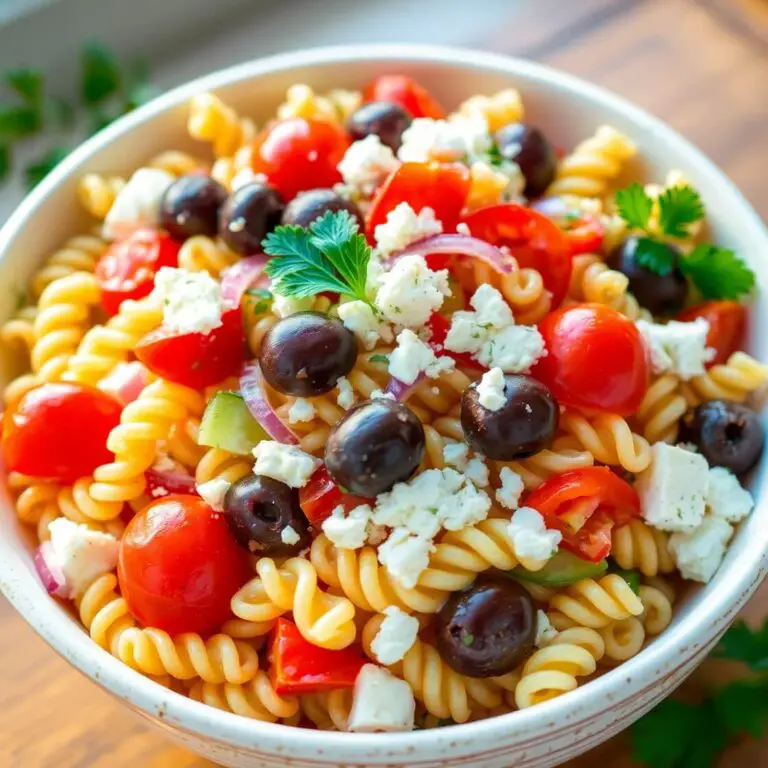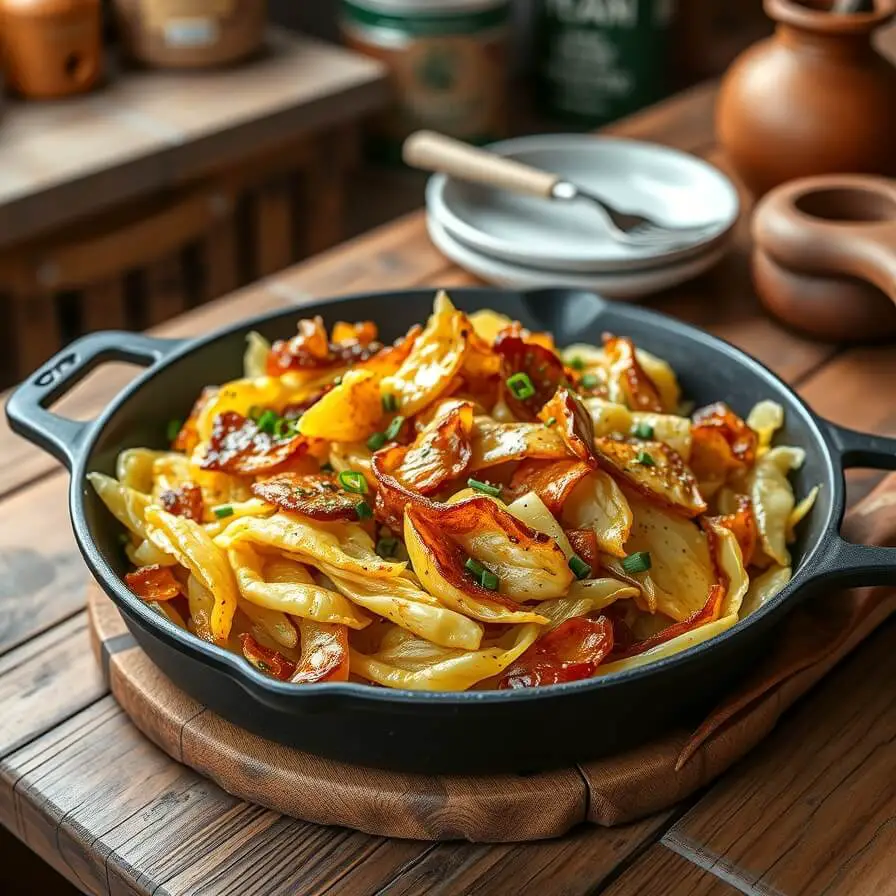
There’s something about the aroma of sizzling cabbage that immediately takes me back to my childhood kitchen. I remember my grandmother standing over the stove, gently tossing chopped cabbage in butter and a pinch of salt, humming softly to herself. The smell was earthy, slightly sweet, and oddly comforting—it filled the whole house with warmth. Over time, I realized that this humble vegetable, often overlooked, had a way of transforming into a dish that was both satisfying and versatile.
I first tried my hand at sauteed cabbage in my own small kitchen, armed with nothing more than a skillet, butter, and a head of green cabbage. To my surprise, the result was something magical: tender leaves with just the right amount of bite, slightly caramelized edges, and a flavor that was deceptively simple yet incredibly nuanced. It quickly became a staple in my weeknight dinners, especially on nights when I wanted something light but flavorful. What I love most about this recipe is how easy it is to adjust to your taste—spicy, sweet, or savory, it’s all possible with a few tweaks.
Sauteed cabbage is more than just a side dish; it’s a canvas for creativity, a quick fix for a weeknight dinner, and a comforting reminder of home-cooked meals. Whether you serve it alongside roasted chicken, mix it into noodles, or enjoy it as a standalone treat, this dish has a way of elevating any meal.
Why I Love This Recipe
There are countless ways to cook cabbage, but sauteing it has always been my favorite. Why? Because it’s quick, it preserves the natural sweetness of the vegetable, and it creates these beautiful golden edges that almost melt in your mouth. Unlike boiling or steaming, which can make cabbage mushy or watery, sauteing locks in flavor while giving the leaves a gentle crispness.
What makes this recipe special is the balance of textures and flavors. The outer leaves get a slight caramelization, adding a subtle crunch, while the inner layers stay soft and tender. A little butter or olive oil, a touch of salt, and a hint of pepper bring out the natural flavors without overpowering them. For me, it’s the kind of dish that doesn’t need to compete for attention—it quietly complements whatever is on your plate.
Another reason I love this recipe is its versatility. You can make it in less than 20 minutes, adjust the seasoning to your preference, and even incorporate extras like garlic, onions, or a splash of vinegar for a tangy twist. It’s a dish that feels both humble and indulgent, perfect for busy weeknights or for impressing guests without much fuss.
Ingredients for Sauteed Cabbage
I like to keep the ingredients simple but fresh. The star here is the cabbage itself, so choosing a crisp, vibrant head is key.
You’ll need a medium to large head of green cabbage, preferably one that feels firm and heavy for its size. Avoid leaves with brown spots or wilting edges—they won’t saute as beautifully. You can also use savoy cabbage if you want a slightly more tender texture, or even red cabbage for a colorful twist.
Butter or olive oil is your cooking fat of choice. Butter adds a rich, nutty flavor, while olive oil brings a lighter, slightly fruity note. I sometimes use a mix of both for depth. Salt and freshly cracked black pepper are essential, but feel free to add a pinch of crushed red pepper flakes if you like a little heat.
Optional additions include minced garlic for an aromatic boost, chopped onions for sweetness, or a splash of apple cider vinegar to brighten the flavor. Some of my friends even like tossing in a few caraway seeds for a traditional touch. The beauty of this recipe is that it’s forgiving—you can adapt it according to what you have in your pantry.
How Much Time Will You Need?
One of the reasons I keep coming back to this recipe is how quick it is. From prep to plate, you’re looking at roughly 20 minutes.
- Preparation time: About 10 minutes to chop the cabbage and gather your ingredients.
- Cooking time: 10 to 12 minutes on the stove, depending on how soft you like your cabbage.
It’s a perfect solution for busy weeknights or when you’re craving something comforting without spending hours in the kitchen.
How to Make Sauteed Cabbage
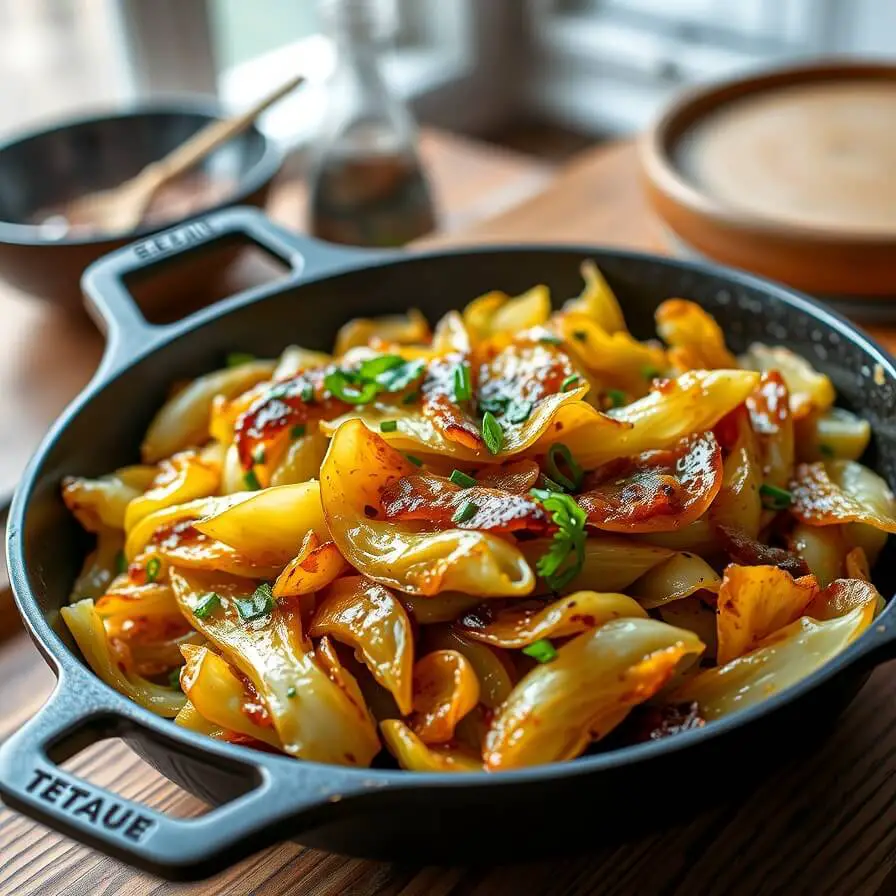
Step – 1: Start by washing your cabbage thoroughly. Remove any outer leaves that look bruised or discolored. Cut the cabbage in half, remove the core, and slice it into thin ribbons. You want them thin enough to cook quickly but thick enough to maintain a bit of bite.
Step – 2: Heat a large skillet over medium heat. Add butter, olive oil, or a combination of both. Once the fat is melted and shimmering, add chopped onions or garlic if using. Saute for a couple of minutes until fragrant.
Step – 3: Add the cabbage to the skillet. Stir to coat the leaves in the butter or oil. Season generously with salt and black pepper. Saute the cabbage, stirring occasionally, for about 8 to 10 minutes. You want the leaves to soften and develop golden, slightly caramelized edges.
Step – 4: Taste and adjust seasoning. If you’d like a touch of brightness, add a splash of vinegar or a squeeze of lemon juice. For a hint of sweetness, a sprinkle of sugar or honey can balance the flavors beautifully.
Step – 5: Remove from heat and serve immediately. You’ll notice the aroma—sweet, earthy, and inviting—it’s that simple yet irresistible.
Substitutions
One of the things I love about this recipe is how adaptable it is. Don’t have butter? Use all olive oil or even avocado oil for a neutral taste. No fresh cabbage on hand? Napa cabbage can work in a pinch, though the texture will be slightly different.
You can also experiment with flavorings. Swap onions for shallots for a subtler taste, or use garlic powder instead of fresh garlic if you’re in a hurry. For a vegan version, stick to oil and consider adding a splash of soy sauce or tamari for an umami punch.
Best Side Dishes for Sauteed Cabbage
Sauteed cabbage is versatile and pairs beautifully with a variety of main dishes. My favorites include:
- Roasted or grilled chicken: The slight sweetness of the cabbage complements the savory, crispy skin.
- Pan-seared fish: Especially white fish like cod or tilapia; the cabbage adds a gentle crunch.
- Mashed potatoes: A classic pairing that turns any meal into a comforting feast.
These combinations make the meal feel complete and balanced, turning a simple sauteed vegetable into a star player on your plate.
Serving and Presentation Tips
There’s something satisfying about plating a simple dish like sauteed cabbage in a way that makes it look almost as good as it tastes. One of my favorite tricks is to serve it in a shallow, wide dish so the caramelized edges are visible. The golden hues immediately catch the eye, and it invites everyone at the table to dig in.
I sometimes finish it with a sprinkle of fresh herbs like parsley, chives, or even a touch of dill. Not only does it add a pop of color, but it also gives a fresh aroma that brightens the dish. For a rustic vibe, I like to serve it in a cast-iron skillet straight from the stove—there’s something comforting about that presentation.
If you’re hosting a dinner, consider layering the cabbage alongside your main dish on the plate instead of simply putting it in a bowl. The contrast of colors—golden cabbage, roasted meat, or mashed potatoes—makes the meal visually appealing. Even a simple drizzle of extra virgin olive oil or a few dots of balsamic glaze can elevate it from humble to elegant.
Tips and Tricks to Make This Recipe Even Better
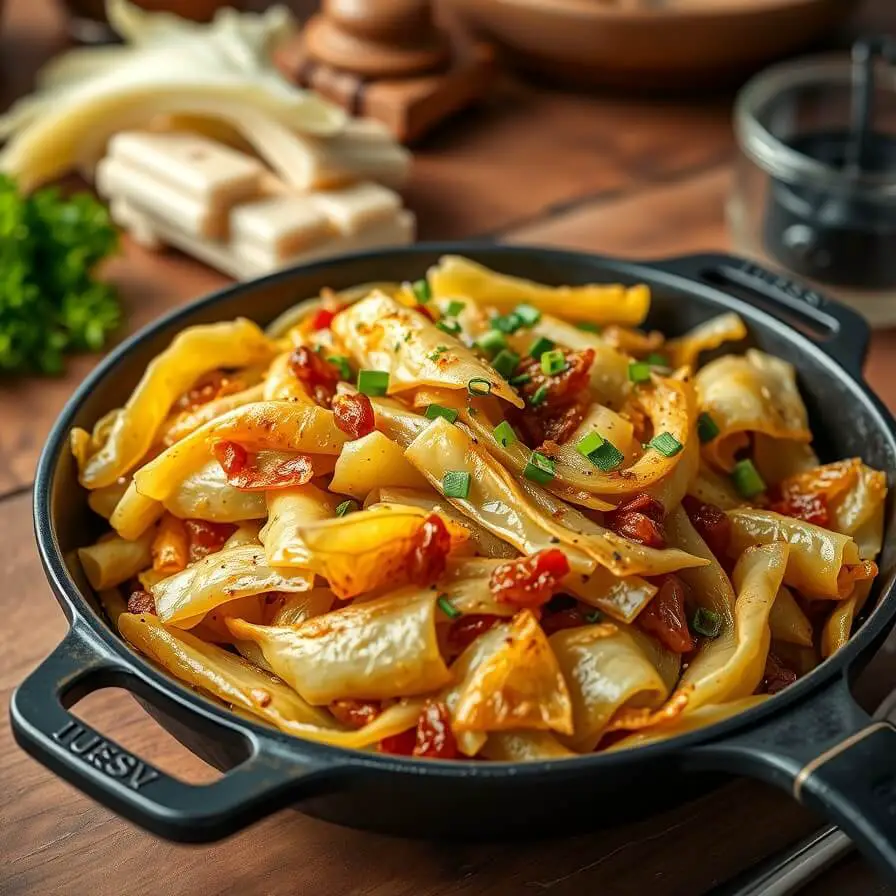
Even a straightforward dish like sauteed cabbage has room for little enhancements. First, make sure your cabbage is sliced evenly. This ensures that all the pieces cook at the same rate and prevents some from getting mushy while others remain raw.
Another tip is to let the cabbage sit in the skillet without stirring too frequently. Giving it a few minutes to caramelize creates those lightly golden edges that add both flavor and texture.
I also love experimenting with seasonings. A pinch of smoked paprika, a little ground nutmeg, or even a dash of soy sauce can transform the flavor profile in exciting ways. If you enjoy a tangy touch, a squeeze of lemon juice at the end brightens the dish beautifully.
Finally, don’t overcrowd the pan. Sauteeing works best when the cabbage has room to cook rather than steam. If you have a lot, cook it in batches for the best texture.
Common Mistakes to Avoid
Even simple recipes can have pitfalls. One common mistake is overcooking the cabbage. While you want it tender, cooking it too long can make it soggy and less flavorful. Keep an eye on it and remove it from heat as soon as it reaches the desired softness.
Another mistake is under-seasoning. Cabbage can be mild on its own, so generous seasoning with salt, pepper, and any optional herbs or spices is essential. Taste as you go—it’s the best way to ensure balanced flavor.
Avoid chopping the cabbage too thickly or unevenly. Uneven pieces cook at different rates, leaving some burnt while others remain raw. Thin, uniform ribbons ensure perfect sauteed results.
Finally, don’t rush the caramelization. A little patience brings out the natural sweetness and depth of flavor that makes this dish truly special.
How to Store It
Leftover sauteed cabbage keeps surprisingly well. Allow it to cool completely, then transfer it to an airtight container and refrigerate for up to 3–4 days. When reheating, a quick stir-fry in a skillet over medium heat brings back some of the original texture. You can also use it as a filling for wraps or toss it into soups, stir-fries, or grain bowls for a quick meal.
If you want to freeze it, blanch the cabbage lightly before sauteing, then freeze in portion-sized containers. Thaw and reheat in a skillet when needed. While the texture may soften slightly, the flavor remains delicious.
FAQ
Can I use red cabbage instead of green cabbage?
Absolutely! Red cabbage works beautifully in this recipe, adding a vibrant color and slightly sweeter taste. Just be mindful that it may take a few extra minutes to soften.
Can I make this recipe vegan?
Yes. Simply substitute butter with olive oil or any plant-based fat. You can also add a splash of soy sauce or nutritional yeast for extra flavor.
Can I add other vegetables?
Definitely! Carrots, bell peppers, or onions mix well with cabbage and can add color, sweetness, and texture. Just adjust cooking times to ensure everything cooks evenly.
How do I keep the cabbage from becoming soggy?
Avoid overcrowding the pan and make sure to cook over medium heat. Give the leaves some space and don’t stir constantly—this encourages caramelization rather than steaming.
Can I make this ahead of time for meal prep?
Yes, it reheats well in a skillet or microwave. It also works as a base for stir-fries, tacos, or grain bowls, making it an excellent meal prep option.

Sauteed Cabbage Recipe
- Total Time: 20–22 minutes
- Yield: 4 1x
- Diet: Vegetarian
Description
This sauteed cabbage recipe transforms a humble vegetable into a delicious, versatile dish. Tender with golden, slightly caramelized edges, it’s perfect as a side or a main component in various meals. Quick to prepare, easy to adapt, and full of flavor, this recipe is a staple for weeknight dinners and a cozy reminder of home-cooked comfort. Whether paired with roasted chicken, fish, or mashed potatoes, it elevates any meal effortlessly.
Ingredients
- 1 medium head of green cabbage, washed, cored, and thinly sliced
- 2 tablespoons butter or olive oil (or a mix)
- 1 small onion, chopped (optional)
- 2 cloves garlic, minced (optional)
- Salt, to taste
- Black pepper, freshly cracked, to taste
- Optional: red pepper flakes, splash of vinegar, lemon juice, or fresh herbs
Instructions
- Heat butter or oil in a large skillet over medium heat.
- Add onions and garlic, sauteing until fragrant (2–3 minutes).
- Add cabbage, stirring to coat with fat, and season with salt and pepper.
- Saute for 8–10 minutes, stirring occasionally, until tender with golden edges.
- Optional: add vinegar, lemon juice, or herbs for extra flavor.
- Serve immediately as a side or incorporate into your favorite dishes.
Notes
- Slice cabbage evenly for uniform cooking.
- Avoid overcrowding the pan to prevent steaming.
- Experiment with spices like paprika, nutmeg, or caraway seeds for variety.
- Prep Time: 10 minutes
- Cook Time: 10–12 minutes
- Category: Side Dish
- Method: Sauteing
- Cuisine: American
Nutrition
- Serving Size: 4
- Calories: 80
- Sugar: 4g
- Sodium: 180mg
- Fat: 5g
- Saturated Fat: 2.5g
- Unsaturated Fat: 2g
- Trans Fat: 0g
- Carbohydrates: 8g
- Fiber: 3g
- Protein: 2g
- Cholesterol: 10mg

